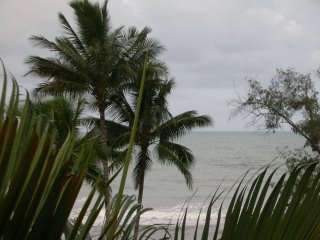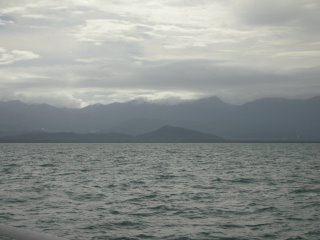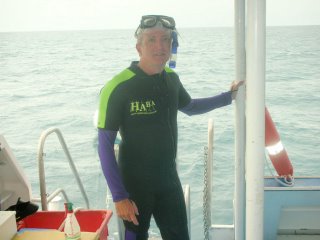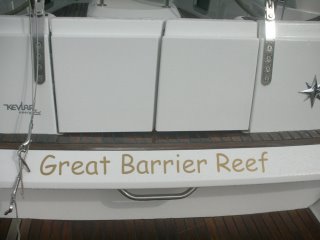The Great Barrier Reef
Queensland. 4,000 km from Adelaide.
It is monsoon season here in the tropics on the 14th parallel south of the equator. The temperature is in the low 30°s and the humidity is 100%. The first evening at our hotel I crawled into a hammock with a glass of wine and was immediately hypnotized by the crashing rhythm of the Coral Sea, part of the Pacific Ocean, at my feet. From our balcony, through the swaying palm trees, the undulating sea conjured up the images we all saw a year ago of the tsunami waves inundating holiday beaches across the South Asia basin. Tonight I am feeling frightened by these waves, by their potential to swallow and destroy, by the raw power of the realm. At the same time I am awed by and respectful of the awesome, tenuous, fragile connection we all have with life.
swaying palm trees, the undulating sea conjured up the images we all saw a year ago of the tsunami waves inundating holiday beaches across the South Asia basin. Tonight I am feeling frightened by these waves, by their potential to swallow and destroy, by the raw power of the realm. At the same time I am awed by and respectful of the awesome, tenuous, fragile connection we all have with life.
Thursday we booked a daylong Great Barrier Reef snorkeling trip. Not cheap (nothing in Australia is). But, I must say, worth every cent. The rains were pelting down with a tropical vengeance when the van picked us up at 7:45. Any one who knows me knows I don’t do mornings, especially mornings during the monsoon season. “Are you sure we should be doing this today?” Art asks the driver. “Why not? You’re going to be wet anyway!” is the reply. An hour and a half later we are 50 nautical miles out into the Pacific on the edge of the Outer Reef. And, as predicted, we are wet.
“Are you sure we should be doing this today?” Art asks the driver. “Why not? You’re going to be wet anyway!” is the reply. An hour and a half later we are 50 nautical miles out into the Pacific on the edge of the Outer Reef. And, as predicted, we are wet.
The Great Barrier Reef is the largest reef system in the world, home to 1,500 species of fish, 400 species of coral, and 4,000 types of mollusc. It stretches from just south of the Tropic of Capricorn to the waters of Papua New Guinea. There are 3,400 identified reefs. It has been designated a World Heritage Site. Check out http://whc.unesco.org/en/list/154 for more information.
There are twenty of us are on the trip. Pulling (and I mean pulling!) on lycra sting suits (the monsoon rains wash the box jellyfish out of the Mangrove swamps, where they have spawned, into the ocean; one sting from a box jellyfish can send you to ICU; two stings and Kim and Rebecca are arranging your flight from Queensland), we let ourselves into the ocean 200 metres from the Reef.
I’m not sure about this. I’m not a great swimmer; I really don’t like the water; I’ve seen the movie “Blue Water” or “Black Water” or “Too Much Water” (what ever); it is a long way down; it is a heck of a swim to shore . . . then I reach the reef . . .
“Black Water” or “Too Much Water” (what ever); it is a long way down; it is a heck of a swim to shore . . . then I reach the reef . . .
The only way to describe the experience is to quote a fellow sailor upon return to the boat an hour and a half later: “I don’t need to see Jesus now.”
I can’t think of a better description of the experience.
For those of us for whom the experience of God’s presence in our midst is most dramatically experienced in the complex wonder and mystery and beauty and awe of creation, the Great Barrier Reef is the ultimate religious experience. The orthodox Jesus of death can’t compare, though the earlier Jesus’ respect for the awesome wonder of God’s Will for Life draws Jesus front and centre to this experience. Jesus, if he experienced such awe without witnessing the Reef, what insight and blessing he must have been part of!
I wish I could describe to you the vivid colours, the complex, wondrous, symbiotic relationships that exist on this shelf. There is a “cleaner fish”. It exists to clean parasites off of other fish. We watch one work. There is a queue of fish, every colour, shape, and size waiting its turn. There is no elbowing (finnning?); size doesn’t matter; each one in turn. We see a sea cucumber. It cleans sand, in one end and out the other. There is a tiny fish that swims in the “other” end, cleans the cuke’s intestines, and swims out its mouth. We saw the cuke, not the cuke’s cleaners. The sea clam. Wow! I found one wide open, a full metre in length. Its mouth was deep, mautled mauve. From its fore-centre a hole would open and a tower emerge. Moments later the tower retreats, closes, and disappears. Litres of seawater have been inhaled to be filtred and processed, nutrients drawn out of it to nourish the clam.
Clown fish! Ha! Skitting in and out of anemones. Parrot fish, with their silly little fins flapping madly (they swim like I do). A school of sixty or so iridescent blue fish 40/50 cm in length envelope me. I want to panic! but don’t, they are so calm. For several minutes they swim with me and then, in a flash, are off. For those moments I felt like part of the clan!
Parrot fish, with their silly little fins flapping madly (they swim like I do). A school of sixty or so iridescent blue fish 40/50 cm in length envelope me. I want to panic! but don’t, they are so calm. For several minutes they swim with me and then, in a flash, are off. For those moments I felt like part of the clan!
Coral. Where does one begin. Black coral. Like a thick wig of the blackest imaginable hair waving effortlessly in the wind. I swim closer and see that each feather of hair has a ruby red spine. Blue, green, yellow coral; tentacles waving, grasping, undulating; fish nibbling, cleaning, pruning. Everyone lives and works together here, providing for, sustaining, and nurturing each other.
I am back at the hotel and back on the beach. We have had a lovely meal and conversation earlier in the evening with folks from Switzerland, California, Washington and Belgium. The Coral Sea continues its relentless crash on the beach at my feet. Tonight I am not feeling frightened by it, though. Visions of towering tsunamis are not playing in my mind. Now I am thinking of the awesome, tenuous, fragile complex connection we all have with all life.
It is monsoon season here in the tropics on the 14th parallel south of the equator. The temperature is in the low 30°s and the humidity is 100%. The first evening at our hotel I crawled into a hammock with a glass of wine and was immediately hypnotized by the crashing rhythm of the Coral Sea, part of the Pacific Ocean, at my feet. From our balcony, through the
 swaying palm trees, the undulating sea conjured up the images we all saw a year ago of the tsunami waves inundating holiday beaches across the South Asia basin. Tonight I am feeling frightened by these waves, by their potential to swallow and destroy, by the raw power of the realm. At the same time I am awed by and respectful of the awesome, tenuous, fragile connection we all have with life.
swaying palm trees, the undulating sea conjured up the images we all saw a year ago of the tsunami waves inundating holiday beaches across the South Asia basin. Tonight I am feeling frightened by these waves, by their potential to swallow and destroy, by the raw power of the realm. At the same time I am awed by and respectful of the awesome, tenuous, fragile connection we all have with life. Thursday we booked a daylong Great Barrier Reef snorkeling trip. Not cheap (nothing in Australia is). But, I must say, worth every cent. The rains were pelting down with a tropical vengeance when the van picked us up at 7:45. Any one who knows me knows I don’t do mornings, especially mornings during the monsoon season.
 “Are you sure we should be doing this today?” Art asks the driver. “Why not? You’re going to be wet anyway!” is the reply. An hour and a half later we are 50 nautical miles out into the Pacific on the edge of the Outer Reef. And, as predicted, we are wet.
“Are you sure we should be doing this today?” Art asks the driver. “Why not? You’re going to be wet anyway!” is the reply. An hour and a half later we are 50 nautical miles out into the Pacific on the edge of the Outer Reef. And, as predicted, we are wet. The Great Barrier Reef is the largest reef system in the world, home to 1,500 species of fish, 400 species of coral, and 4,000 types of mollusc. It stretches from just south of the Tropic of Capricorn to the waters of Papua New Guinea. There are 3,400 identified reefs. It has been designated a World Heritage Site. Check out http://whc.unesco.org/en/list/154 for more information.
There are twenty of us are on the trip. Pulling (and I mean pulling!) on lycra sting suits (the monsoon rains wash the box jellyfish out of the Mangrove swamps, where they have spawned, into the ocean; one sting from a box jellyfish can send you to ICU; two stings and Kim and Rebecca are arranging your flight from Queensland), we let ourselves into the ocean 200 metres from the Reef.
I’m not sure about this. I’m not a great swimmer; I really don’t like the water; I’ve seen the movie “Blue Water” or
 “Black Water” or “Too Much Water” (what ever); it is a long way down; it is a heck of a swim to shore . . . then I reach the reef . . .
“Black Water” or “Too Much Water” (what ever); it is a long way down; it is a heck of a swim to shore . . . then I reach the reef . . .The only way to describe the experience is to quote a fellow sailor upon return to the boat an hour and a half later: “I don’t need to see Jesus now.”
I can’t think of a better description of the experience.
For those of us for whom the experience of God’s presence in our midst is most dramatically experienced in the complex wonder and mystery and beauty and awe of creation, the Great Barrier Reef is the ultimate religious experience. The orthodox Jesus of death can’t compare, though the earlier Jesus’ respect for the awesome wonder of God’s Will for Life draws Jesus front and centre to this experience. Jesus, if he experienced such awe without witnessing the Reef, what insight and blessing he must have been part of!
I wish I could describe to you the vivid colours, the complex, wondrous, symbiotic relationships that exist on this shelf. There is a “cleaner fish”. It exists to clean parasites off of other fish. We watch one work. There is a queue of fish, every colour, shape, and size waiting its turn. There is no elbowing (finnning?); size doesn’t matter; each one in turn. We see a sea cucumber. It cleans sand, in one end and out the other. There is a tiny fish that swims in the “other” end, cleans the cuke’s intestines, and swims out its mouth. We saw the cuke, not the cuke’s cleaners. The sea clam. Wow! I found one wide open, a full metre in length. Its mouth was deep, mautled mauve. From its fore-centre a hole would open and a tower emerge. Moments later the tower retreats, closes, and disappears. Litres of seawater have been inhaled to be filtred and processed, nutrients drawn out of it to nourish the clam.
Clown fish! Ha! Skitting in and out of anemones.
 Parrot fish, with their silly little fins flapping madly (they swim like I do). A school of sixty or so iridescent blue fish 40/50 cm in length envelope me. I want to panic! but don’t, they are so calm. For several minutes they swim with me and then, in a flash, are off. For those moments I felt like part of the clan!
Parrot fish, with their silly little fins flapping madly (they swim like I do). A school of sixty or so iridescent blue fish 40/50 cm in length envelope me. I want to panic! but don’t, they are so calm. For several minutes they swim with me and then, in a flash, are off. For those moments I felt like part of the clan!Coral. Where does one begin. Black coral. Like a thick wig of the blackest imaginable hair waving effortlessly in the wind. I swim closer and see that each feather of hair has a ruby red spine. Blue, green, yellow coral; tentacles waving, grasping, undulating; fish nibbling, cleaning, pruning. Everyone lives and works together here, providing for, sustaining, and nurturing each other.
I am back at the hotel and back on the beach. We have had a lovely meal and conversation earlier in the evening with folks from Switzerland, California, Washington and Belgium. The Coral Sea continues its relentless crash on the beach at my feet. Tonight I am not feeling frightened by it, though. Visions of towering tsunamis are not playing in my mind. Now I am thinking of the awesome, tenuous, fragile complex connection we all have with all life.
1 Comments:
Ok, I'm not sure if it's the lack of sleep as I'm just getting off of the midnight shift......but I have to say Alan......you look pretty good in the laytex suit. Did a rubber mask come with it? I've got one from Fight Nite you can borrow.
After a good sleep I'll read the entry. Glad you're doing well.
Post a Comment
<< Home